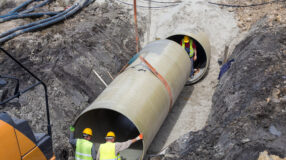America’s interstate natural gas transmission industry has made great strides in recent years in reducing the amount of natural gas released from pipeline systems, thanks in part to pipeline safety efforts and modernization and expansion projects to ensure system reliability and resiliency. INGAA’s board of directors is committed to building on the industry’s success in reducing emissions by developing guidelines that enhance efforts to discover and repair leaks from pipelines and associated equipment.
“The natural gas transmission pipeline industry reduced the number of leaks by 94 percent, preventing 122 million metric tons of CO2-equivalent emissions over the past three decades, as a result of pipeline integrity and maintenance programs and continued investment in new pipeline facilities. These prevented emissions are equivalent to removing more than 25 million passenger vehicles from the road for one year,” said INGAA President and CEO Don Santa. “We are committed to go even further by establishing guidelines to reduce emissions from pipeline equipment, with a particular focus on the types of equipment with the largest emissions profile.”
INGAA will develop industry guidelines for Directed Inspection and Maintenance (DI&M) of natural gas pipeline facilities. DI&M is a well-established and EPA-recognized tool for detecting and mitigating leaks in a cost-effective manner. While most INGAA member pipeline companies use DI&M, the guidelines will improve consistency and uniformity, which should result in further emissions reductions. INGAA will work with research groups to create a roadmap for developing technological innovations to make DI&M even more effective. In addition, INGAA, along with several member companies, is working with Colorado State University and Carnegie Mellon University in collaboration with the Environmental Defense Fund to help further validate and refine the estimates of GHG emissions from transmission and storage facilities.
As the industry invests in building new pipelines and expanding existing systems to meet growing demand, operators rely upon the latest and most efficient equipment to improve efficiency, reduce operational costs and also the amount of natural gas released into the atmosphere. An INGAA Foundation research report released in March estimated that the United States and Canada will require each year through 2035 an average of 850 miles of new natural gas transmission mainlines, 800 miles of new laterals to and from power plants, processing facilities and storage fields and almost 14,000 miles of new gas gathering lines to bring new gas supplies to growing markets. In addition to creating significant economic benefits, this estimated $30 billion per year investment in midstream pipeline infrastructure will benefit the environment by reducing upstream and downstream greenhouse gas emissions, because less gas will be flared and more gas will be used to displace higher emitting fuels. Improvements to the pipeline permitting process would help the nation to realize more rapidly and more fully the benefits of its natural gas abundance.
INGAA looks forward to working with the administration to find other partnership opportunities, including research and development, to encourage even greater emissions reductions from natural gas transmission pipelines.






